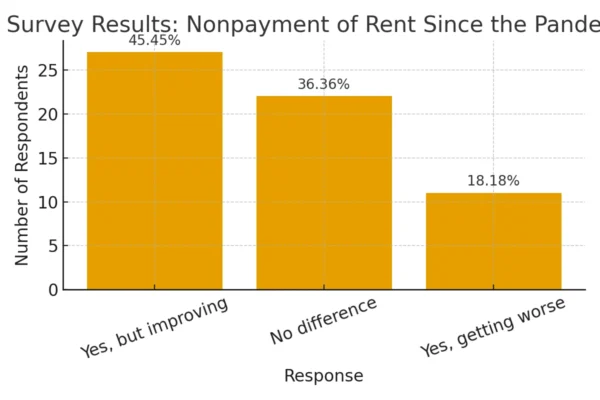Normal Wear and Tear For Rental Properties
 Renting out a property will eventually lead to some scuffs, scrapes and stains from renters — and the longer a tenant lives in a property, the more potential there is for accidents and everyday deterioration.
Renting out a property will eventually lead to some scuffs, scrapes and stains from renters — and the longer a tenant lives in a property, the more potential there is for accidents and everyday deterioration.
In the U.S., the onus is on landlords to understand that a certain level of wear and tear is unavoidable and an expected part of renting out a unit or home. However, in the case of excessive damage or repairs, a landlord or property manager can make a tenant pay to fix it. Similarly, it’s not uncommon for a landlord or property manager to withhold a portion or the entirety of a security deposit to fix these issues when the tenant moves out.
Important note: If a landlord tries to withhold the security deposit without valid, documented reasons, many states have implemented legislation that will safeguard tenants from this — making landlords potentially liable if they do not adhere to the applicable regulations.
Read on to discover what constitutes normal wear and tear, as well as tips for addressing damage concerns with occupants.
What is normal wear and tear?
For a landlord, normal wear and tear typically refers to any damage that takes place as the result of aging and/or regular usage.
It’s important to remember, however, that each case is unique and not everyone has the same expectations when referring to normal wear and tear. Where one landlord may see typical damage from everyday use, another might consider it excessive wear.
However, below are common examples of normal wear and tear that landlords can use as a reference:
- Small nail holes
- Minor scrapes in wall paint
- Peeling wallpaper
- Scuff marks on linoleum flooring
- Worn enamel
- Minorly chipped wall plaster
- Loose or dirty grouting
- Cracked paint
- Carpet deterioration caused by foot traffic, normal use, etc.
- Broken cords on blinds or curtains
- Fading on carpets or flooring caused by sun exposure
- Non-functional light bulbs, wiring issues, etc.
- Loose door handles, hinges, cabinetry, etc.
- Leaky toilets
- Broken light switch plates
Normal wear and tear vs. excessive damage
In contrast to normal wear and tear, excessive damage is the avoidable destruction to or loss of property. Typically this type of damage may occur accidentally, on purpose, or due to neglect of the rental property.
It isn’t always easy for a landlord to determine when an issue qualifies as excessive damage, or when the responsibility should fall on the tenant to repair a particular concern. But there are three clear-cut guidelines that can help a landlord differentiate between ordinary wear and tear vs. unreasonable damage:
- Wear and tear does NOT include damages that occur as a result of a tenant’s negligence, abuse or accidental destruction.
- Wear and tear does NOT include damages that occur as a result of negligence, abuse or accidental destruction by a tenant’s guests or pets.
- Excessive damage does NOT include the cost of regular maintenance and repairs that must be completed after a tenant moves out and prior to another tenant occupying the space.
A tenant may actively dispute a landlord’s definition of excessive damage, which is why documentation and evidence are critical for property owners. If the situation escalates and the landlord-tenant dispute is handled in court, it will be up to a judge’s discretion to determine if an inappropriate amount of property damage has occurred.
It’s also important to remember that laws differ from state to state, so rulings relating to these types of issues can vary significantly.
Below are common examples of excessive damage that landlords can use as a helpful reference:
- Excessive amounts of pet urine on carpets
- Smoke or burn marks from cigarettes on flooring, walls, etc.
- Broken or missing cabinet doors
- Unauthorized renovations
- Gaping holes in walls, doors, etc.
- Smashed mirrors, broken window glass, etc.
- Clogged toilets as a result of improper use
- Missing items
- Broken enamel in bathtubs, sinks, toilets, etc.
The above are all issues that landlords would be justified in deducting from a tenant’s security deposit.
What constitutes routine maintenance for a landlord?
When determining the differences between ordinary wear and tear vs. excessive damage, it’s also essential that landlords understand what should be considered regular property maintenance.
For day-to-day use, a landlord, property manager or property management company should be regularly doing or checking up on the following:
- Rodent or insect exterminations
- Repairing of water damage or leaks
- Installing functioning fire and carbon monoxide detectors
- Gutter cleanings
- Sprinkler system repairs
- Safety inspections
- Replacing fire extinguishers
- Updating or replacing of kitchen appliances
If you aren’t sure whether or not an issue qualifies as a reasonable wear and tear rental concern, it’s always advisable to seek a second opinion. As mentioned before, too often, landlords bring their case to court, only to realize their definition of wear and tear rental property issues differs from the definition set forth by their local and/or state law.
How does normal wear and tear affect the security deposit?
There is no scenario where normal wear and tear can legally affect the security deposit. A landlord cannot withhold any portion of a tenant’s security deposit for repair costs if the property doesn’t show excessive damage.
Landlords are expected to cover costs for regular wear and tear repairs, and should budget accordingly to protect their bottom line. A consistent maintenance plan can help landlords and property managers keep track of the rental property’s condition and avoid any future disputes with the tenant(s).
How does excessive damage affect the security deposit?
On the other hand, excessive damage can affect a tenant’s security deposit refund. A landlord or property owner can typically deduct from the security deposit to hold a tenant responsible for any unreasonable damage that’s affected the rental unit.
Each state’s security deposit laws vary, so be sure to check with an attorney before doing so.
How much should a landlord deduct from a tenant’s security deposit?
For excessive damage and/or cleaning fees, it’s best practice for a landlord to hire a contractor or cleaning company to give an estimate on their repairs and services for the rental. This amount can then be deducted from the security deposit.
If a landlord chooses to make their own estimate, it’s important to document a detailed charge list to show exactly how that deduction is reached.
Whichever option a landlord chooses, be sure to send the comprehensive charge list to the tenant so they understand why their security deposit has been affected. This charge list will be the first line of defense for a landlord if the tenant decides to dispute the charges in small-claims court.
How AAOA can help
Simplify property management with AAOA’s broad range of resources, including tenant screening services, tenant background checks and a comprehensive library of landlord tenant laws for every U.S. state — which you can access at any time.
Looking for additional resources for landlords? AAOA offers industry-leading services and materials to help you make the most informed decision possible.
The information provided herein is for advisory purposes only and AAOA takes no responsibility for its accuracy. AAOA recommends you consult with an attorney familiar with current federal, state and local laws.













 Accessibility
Accessibility